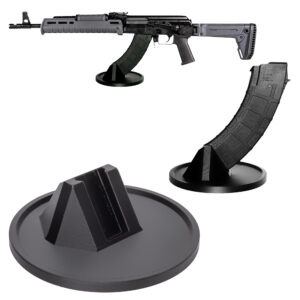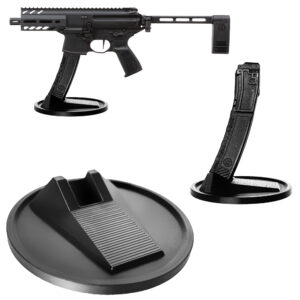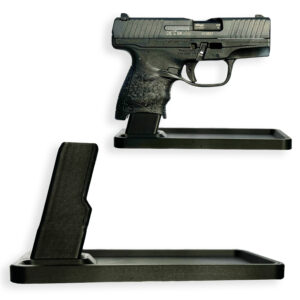
Categories:
In our modern society, the topic of gun ownership and gun control has become a contentious issue. However, regardless of one’s stance on the matter, it is essential to recognize that safe gun handling is of utmost importance. Whether you are a seasoned gun enthusiast or an individual who has never held a gun before, understanding and practicing safe gun handling should be a priority.
The significance of safe gun handling cannot be overstated as it directly impacts the safety and well-being of individuals in various settings. Whether you own a gun for self-defense purposes, recreational activities such as hunting or sport shooting, or work in professions that require guns, adhering to strict safety protocols is crucial to prevent accidents and potential tragedies.
Accidental gun-related incidents can have devastating consequences for both individuals and communities. Mishandling guns can lead to unintentional discharges resulting in injury or loss of life. These incidents not only cause immeasurable pain and suffering but also contribute to public fear surrounding guns.
By emphasizing safe gun handling practices, we can minimize the risks associated with guns while promoting responsible ownership. This includes understanding how guns work, proper storage methods to prevent unauthorized access, ensuring proper maintenance for reliable performance, and most importantly, following established safety procedures at all times when handling guns.
In this text about safe gun handling, we will explore the fundamental principles that underpin responsible gun ownership. By equipping ourselves with knowledge about safe practices and fostering a culture focused on responsible behavior regarding guns, we can strive towards creating safer environments for everyone involved in gun-related activities.
When it comes to safe gun handling, understanding and following gun safety rules is of paramount importance. These rules are designed to prevent accidents, injuries, and even fatalities that can occur due to mishandling guns. By adhering to these guidelines, gun owners can ensure the safety of themselves and those around them. Firstly, always treat every gun as if it is loaded.
Regardless of whether you believe the gun is unloaded or have personally confirmed its status, never assume it to be so. This rule emphasizes the need for utmost caution at all times when handling guns. Secondly, keep your finger off the trigger until you are ready to shoot. This fundamental rule prevents accidental discharges that may occur due to an unintentional twitch or a momentary lapse in concentration.
By maintaining proper trigger discipline, you minimize the risk of an unintended discharge. Next, never point a gun at anything you do not intend to shoot. This rule ensures that the muzzle is always directed in a safe direction away from people or objects that could be harmed by an accidental discharge. Furthermore, be aware of your target and what lies beyond it.
Understanding your surroundings and what may be affected by a bullet’s path helps prevent unintended consequences such as stray bullets causing damage or harm. Lastly, familiarize yourself with your specific gun’s manual and operation before use. Each gun has unique features and mechanisms that require understanding for safe handling practices. In conclusion, comprehending and adhering to these essential gun safety rules are critical for responsible gun ownership.
Ensuring the safe storage and secure handling of guns is of paramount importance to prevent accidents, unauthorized access, and potential misuse. Responsible gun owners understand that taking appropriate measures can significantly reduce the risk of tragic incidents involving guns. Here are key guidelines for proper storage and secure gun handling:
1. Safe Storage: Guns should always be stored in a secure location inaccessible to unauthorized individuals, especially children or those with mental health issues. Utilize a sturdy lockable gun safe or cabinet designed specifically for gun storage. Ensure the safe is properly installed, anchored, or bolted to prevent theft.
2. Ammunition Separation: Store ammunition separately from guns in a locked container or safe. This practice reduces the likelihood of accidental discharge by eliminating easy access to loaded guns.
3. Trigger Locks: Use trigger locks when guns are not in use, rendering them inoperable until removed. These inexpensive devices help prevent accidental discharges and unauthorized use.
4. Unattended Guns: Never leave a gun unattended, even momentarily; this includes vehicles, workplaces, or public spaces like restrooms or dressing rooms where others could gain access.
5. Education and Training: Gain comprehensive knowledge about guns safety through accredited training programs offered by certified instructors or organizations such as the National Rifle Association (NRA). Educating yourself about proper gun handling techniques and safety protocols is essential for responsible ownership.
By following these guidelines for proper storage and secure gun handling, responsible gun owners can significantly contribute to reducing accidents while ensuring their weapons remain out of reach from unauthorized individuals who may misuse them.
When it comes to safe gun handling, having the right safety equipment is crucial. These essential items not only protect the shooter but also those around them. Whether you are a seasoned gun enthusiast or a novice shooter, here are some important safety equipment options to consider:
1. Eye Protection: Wearing appropriate eye protection, such as shooting glasses or goggles, is essential to shield your eyes from potential debris, ejected shells, or ricochets. Proper eye protection can prevent severe injuries and maintain clear vision while shooting. 2. Ear Protection: Exposure to loud gunshots can cause permanent hearing damage. To safeguard your hearing, it is imperative to use earmuffs or earplugs designed specifically for shooting activities.
These protective devices reduce the noise levels without hindering communication on the range. 3. Gun Cleaning Kit: Maintaining a clean and functional gun is vital for safe operation. A cleaning kit consisting of brushes, patches, solvents, and lubricants allows you to keep your guns in optimal condition and helps prevent malfunctions that could result in accidents. 4. Gun Storage Solutions: Responsible gun ownership includes proper storage when guns are not in use.
Invest in secure gun safes or lockboxes that prevent unauthorized access by children or individuals who should not have access to guns. 5. Range Bag: A dedicated range bag keeps all your gear organized and easily accessible during shooting sessions while ensuring safe transportation of guns and ammunition. Remember that safety should always be a top priority when handling guns; hence investing in appropriate safety equipment is essential for every responsible gun owner or shooter.
One of the fundamental principles of safe gun handling is to ensure that guns are always kept clear and unloaded when not in use. This essential practice serves as a crucial safeguard against unintentional discharge, accidents, and potential harm. By maintaining a clear and unloaded gun, individuals can significantly reduce the risk of injury to themselves or others.
To begin with, it is vital to always treat every gun as if it were loaded. Regardless of whether you believe a gun is unloaded or have personally checked it, never assume its condition without verifying it yourself. Develop the habit of consistently performing safety checks before handling any gun, even if you were the last person to use it.
When not actively engaged in shooting or target practice, guns should be stored securely in locked cabinets or safes. This prevents unauthorized access and ensures that they remain out of reach from children, curious individuals, or those who may misuse them accidentally or intentionally.
Furthermore, during transportation or handing over guns to others for inspection or cleaning purposes—whether at home or at the range—it is crucial always to verify that the weapon is empty by visually inspecting both the chamber and magazine well. Additionally, using physical touch by inserting your finger into these areas allows for tactile confirmation that there are no rounds present.
By consistently adhering to these practices, individuals demonstrate their commitment to responsible gun ownership and safe handling procedures. Maintaining a clear and unloaded gun at all times significantly reduces potential risks associated with accidental discharges while ensuring maximum safety for everyone involved in its vicinity.
When visiting a shooting range, it is crucial to prioritize safety above all else. Adhering to safe handling practices ensures that accidents are minimized and everyone present can enjoy their shooting experience. Whether you are a seasoned shooter or a beginner, following these guidelines will contribute to a safe and enjoyable time at the range. First and foremost, always treat every gun as if it is loaded.
This fundamental rule cannot be stressed enough. Regardless of whether someone has assured you that a gun is unloaded, never assume it to be true. Always visually inspect the chamber and magazine for ammunition before handling any gun. Moreover, keep your finger off the trigger until ready to shoot. Maintaining strict trigger discipline prevents accidental discharges and potential injuries. Instead, rest your finger along the frame or slide of the gun until you are ready to aim at your target.
Additionally, it is vital to point the muzzle in a safe direction at all times. Whether you are holding or holstering a gun, ensure that it is pointed downrange or toward an area designated as safe by range personnel. Never point a gun at anything you do not intend to shoot; this simple rule helps prevent accidents caused by negligent discharge.
Lastly, adhere strictly to range rules and regulations. Each shooting range may have its own set of specific guidelines; therefore, familiarize yourself with them before commencing shooting activities. Following these rules not only ensures personal safety but also contributes to maintaining an environment where everyone can enjoy their shooting experience.
When it comes to gun safety, it is crucial to educate children from an early age about the importance of responsible gun handling. Teaching children about guns does not mean encouraging them to use guns but rather equipping them with knowledge and skills that promote safe behavior around guns. By instilling these principles, we can help reduce the risk of accidents and ensure their safety.
The first step in teaching children about gun safety is creating open lines of communication. Parents or guardians should initiate age-appropriate conversations, emphasizing that guns are not toys and should never be touched without adult supervision. These discussions can cover the potential dangers associated with guns and emphasize the importance of treating all guns as if they are loaded.
Furthermore, children should be taught to immediately report any encounter with a gun to a trusted adult. They need to understand that curiosity may lead them to explore a gun if they come across one, which is why it is vital for them to know how to respond responsibly.
Hands-on training can also play an essential role in teaching children about gun safety. Under proper supervision from knowledgeable adults, children can learn how guns work, including their various parts and functions. This practical experience helps debunk myths surrounding guns while reinforcing the message that only responsible adults should handle guns.
In conclusion, teaching children about gun safety involves open communication, emphasizing responsible behavior around guns, and providing hands-on training when appropriate. By educating our young ones about safe gun handling practices from an early age, we can foster a culture of responsibility and ensure their well-being.
The safe and responsible carry and transport of guns is paramount for both the gun owner’s personal safety and the well-being of those around them. Whether you are an experienced shooter or a novice, it is crucial to follow proper guidelines to prevent accidents and ensure that guns remain secure at all times. Firstly, always treat every gun as if it is loaded.
This fundamental rule serves as a constant reminder to handle guns with utmost care. Keep your finger off the trigger until you are ready to shoot, ensuring that it remains outside the trigger guard. Maintaining this discipline reduces the risk of accidental discharge. When carrying a gun, choose a sturdy holster or secure carrying case specifically designed for your type of weapon.
The holster should cover the trigger guard entirely and provide adequate retention to prevent unintended access by unauthorized individuals. Ensure that your chosen method of carry does not obstruct your ability to move freely or interfere with your line of sight. During transportation, it is essential to unload the gun and place it in a locked container separate from ammunition. This separation minimizes any potential hazards during transit and prevents unauthorized access.
Additionally, never leave guns unattended in vehicles; instead, take them directly from one secure location to another. Lastly, familiarize yourself with local laws regarding gun transport; regulations may vary depending on jurisdiction. Complying with these legal requirements demonstrates responsible gun ownership while avoiding unnecessary legal complications. By adhering to these guidelines for responsible carry and transport, gun owners can prioritize safety while effectively exercising their rights within society’s framework.
In conclusion, promoting a culture of safe gun handling is crucial for the well-being and safety of individuals, families, and communities. By following the principles discussed throughout this text, we can significantly reduce the risk of accidents, injuries, and fatalities associated with guns. Firstly, education plays a vital role in fostering responsible gun ownership. Providing comprehensive training courses on safe gun handling practices should be encouraged for all individuals who own or have access to guns.
This includes emphasizing the importance of proper storage, regular maintenance, and understanding the potential risks associated with guns. Secondly, creating awareness about safe gun handling should be an ongoing effort within our society. By regularly sharing information through various channels such as social media campaigns or public service announcements, we can ensure that these important messages reach as many people as possible.
Additionally, fostering an open dialogue about gun safety is essential. Encouraging discussions among family members and friends about responsible gun use can help build a shared understanding and reinforce good habits when it comes to handling guns safely. Moreover, policymakers must prioritize implementing stricter regulations to prevent unauthorized access to guns while maintaining respect for individual rights protected by law. Background checks for all potential buyers and providing resources for mental health evaluations are just some examples of measures that can contribute to safer gun ownership.
Ultimately, promoting a culture of safe gun handling requires collective efforts from individuals, communities, organizations, and governments alike.








Colt
Colt M4 Carbine
Colt LE6920
Colt AR-15 A4
Daniel Defense
DDM4 V7
DDM4 V9
DDM4 V11
DDM4 ISR (Integrally Suppressed Rifle)
Smith & Wesson (S&W)
M&P15 Sport II
M&P15 Tactical
M&P15T
Bravo Company Manufacturing (BCM)
BCM Recce-16
BCM Recce-14
BCM MCMR Series
Aero Precision
M4E1 Series
AC-15
AR15 Pistol (Various Configurations)
Ruger
Ruger AR-556
Ruger SR-556
Ruger AR-556 MPR (Multi-Purpose Rifle)
Springfield Armory
Saint Victor
Saint Edge
Saint AR-15
PSA (Palmetto State Armory)
PSA PA-15
PSA AR-V
PSA Jakl (AR Pistol)
FN America
FN 15 Tactical Carbine
FN 15 Patrol
FN 15 DMR
Wilson Combat
Recon Tactical
Super Sniper
Protector Carbine
SIG Sauer
SIG M400 Tread
SIG M400 Elite
SIG M400 SDI
LWRC International
IC DI (Direct Impingement)
IC SPR
IC A5
Bushmaster Guns
XM-15 QRC
Bushmaster MOE
XM-15 Patrolman
Rock River Arms
LAR-15 Entry Tactical
LAR-15 Predator
LAR-15 Elite Comp
Stag Arms
Stag 15 Tactical
Stag 15L (Left-Handed Models)
Stag 15 Valkyrie
Noveske Rifleworks
Noveske Gen 4 N4
Noveske Space Invader (AR Pistol)
Noveske Recon
Anderson Manufacturing
AM-15 Optic Ready
AM-15 M4 Carbine
AM-15 Precision Rifle
Adams Arms
AA-15 Piston Rifle
P2 AARS (Adams Arms Rifle Series)
Black Rain Ordnance
SPEC15 Series
BRO Predator
Fallout 15
Diamondback Guns
DB15 Series
DB15CCMLB
DB15EB
Del-Ton Inc.
DTI-15
Del-Ton Echo 316H
Sierra 316M
Windham Weaponry
Windham SRC
Windham VEX-SS
Windham RMCS-4 (Caliber Conversion System)
Christensen Arms
CA-15 G2
CA-15 Recon
CA-15 Titanium Edition
Patriot Ordnance Factory (POF-USA)
Renegade Plus
P415 Edge
Revolution DI
LaRue Tactical
PredatAR
OBR (Optimized Battle Rifle)
LaRue Stealth 2.0
Battle Arms Development
Workhorse Patrol Carbine
BAD556-LW (Lightweight)
Authority Elite Rifle
Faxon Guns
Ascent AR-15
FX-19 (AR Pistol)
Streamline Ultralight Series
KE Arms
KE-15 SLT (Super Lightweight Tactical)
KE-15 Scout Carbine
Primary Weapons Systems (PWS)
MK1 MOD 2-M
MK116 PRO
MK107 (Piston AR Pistol)
ZEV Technologies
ZEV Core Elite Rifle
ZEV AR15 Billet Rifles
Franklin Armory
BFSIII AR-C1
Militia Model
F17-L (Chambered in .17 WSM)
Seekins Precision
SP15 DMR
NX15 Skeletonized Rifle
Havak Bravo
Aero Precision (Additional Models)
EPC-9 (Pistol Caliber ARs)
VG6 AR Rifles
Barrett Guns
REC7 DI
REC7 Gen II
CMMG
MK4 RCE
Resolute 300
Banshee (AR Pistol)
DPMS Panther Arms
Panther Oracle
Panther LR-308
H&K (Heckler & Koch)
HK MR556A1
HK416 (Military Variant)
Rock Island Armory (Armscor)
VR-80 Tactical AR (Shotgun AR Platform)
Troy Industries
Troy SPC-A3
Troy PAR (Pump Action AR)
Wilson Tactical
Tactical Recon AR
Protector Series
F1 Guns
FDR-15 Skeletonized Rifle
BDRx-15 Series
Juggernaut Tactical
JT-15
JT-10 Precision Rifle
AeroSurplus
Surplus AR-15 Rifles (Budget Models)
Thunder Tactical
AR-15 Basic Carbine
Tactical Builder Sets
Radical Guns
RF-15
Forged AR-Series
Dark Storm Industries
DS-15 Featureless Rifles
DS-10 Typhoon
DRD Tactical
Paratus
Aptus AR Rifles
Bear Creek Arsenal
BCA-15
AR Complete Upper Builds
Aero Survival Rifles (ASI)
ASR Tactical Series
Tactical Edge
WARFIGHTER Series
AR-15 Lightweight Rifles
Lone Star Armory
TX15 DMR
TX15 Carbine
HERA Arms
HERA H7
HERA AR-15 Lower Builds
IWI (Israeli Weapon Industries)
Zion-15
DRD Tactical
Tactical Modular Rifles
Quick-Takedown Rifles
V Seven Weapons
1776 Rifle
Hyperlite Rifle
Core Rifle Systems
Core15 Tac III
Core15 Patrol Rifle
Armalite (Original AR-15 Creator)
M15 Tactical
M15 A4 Carbine
DEF15 (Defensive Sporting Rifle Series)
PSA (Palmetto State Armory Additional Models)
PSAK-47 Hybrid (AR-AK Style Hybrid)
PSA Dagger (Pistol Caliber Configurations)
Odin Works
OTR-15
Odin Recon Rifle
Maxim Defense
MDX-508 PDX (Compact AR Pistol)
MDX-510 Rifle